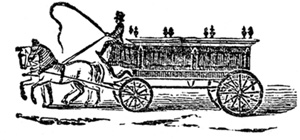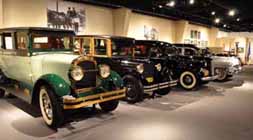|
SEARCH MY WASHINGTON COUNTY PENNSYLVANIA WEBSITES
History of and Other Families (o_f) from
The City and County of Washington Pennsylvania
Enhance your genealogy research about families in Little Washington, Washington County PA
using newspaper articles, birth, death, marriage, notices, obituaries (often with cemeteries
named), probates, deeds, surname finds, family trees, family histories, reunions and other information.
Site Search or Page Search (Ctl Key+F) easily finds items of interest.
Washington County Pennsylvania History and Families
Deaths and Obituaries of People with ties to Washington County PA
 
Pre-1900s Undertaker's Horse-drawn Wagon, and early 1900s
automobile hearses.
All McDonald Newspaper Items from Victoria Hospodar Valentine,
researcher and transcriber.
Unless noted, all other Newspaper Items from Judith
Florian, researcher, transcriber, webmaster.

Partial Obituary of Samuel Ross 1815
1815
Article from The Daily Reporter newspaper, Washington Co., Pa.,
October, unknown day, 1815, page unknown:
Memorial Day at Lone Pine - [not complete article, sorry] Samuel
Ross died Oct. 22, 1815 at age 50... buried in the cemetery on the D.
L. Frazee farm...
* Civil War Soldier
* Only tombstone left on farm.
Description of burial ground location and its
history - The D. L. Frazee Farm was
on the left along "the road to Amity" about 1/2 mile from
the intersection of Rt. 519S and Route 40E The National Pike.
The burial grounds sit in a field on a steep hill behind and above the
house. I was told that prior to the 1950s, the property owner at
the time decided to plow up the field for planting. The owner
removed approximately 20-30 headstones, except for Samuel Ross,
veteran. NO bodies or caskets were moved. This owner then,
reportedly, plowed the field and laid the tombstones to line his
driveway (to make the bed over a previous mud-dirt driveway).
According to the story, the owner had asphalt applied over the
tombstones. *NO written Census was made of the tombstone names!
The D. L. Frazee farm prior to 1815-16 had been part
of the Joseph BAKER property, which sat from the border of The
National Pike on the eastern side of "the road to Glyde",
down the eastern side and across to the opposite hill.
Joseph
Ross moved there in about 1809 from Frederick Co. MD. He brought
with him
his wife, Mary ___, son, Phillip BAKER, daughter Catherine BAKER LANE
with husband John LANE Sr and their first two children, John LANE Jr
about aged 4, and Joseph BAKER, about aged 2 years (At least 2 more
children were born on this farm, Daniel Lane, b. 1810 and Mary A. Lane
b. 1818 [later married Samuel Flowers]). Shortly after
moving to Washington County in 1809, Joseph Baker petitioned for a road to be
laid (the road to Glyde) through his property. The road to Glyde, now
assigned a State Route (S.R.) number, connects the area west of Scenery Hill
PA to Glyde and Amity, PA which gives a southeasterly access to Marianna, PA
from the Ten Mile Creek and "Ten Mile Country" area. This piece of
the property was later split off and ended up later as the Frazee farm.
"The Summer that Never Was" occurred in
1816.
Wikipedia explains what this saying means:
"The year 1816 is known as the Year Without a Summer (also the Poverty Year,
the Summer that Never Was, Year There Was No Summer, and Eighteen Hundred and Froze
to Death[1]), because of severeclimate abnormalities that caused average global
temperatures to decrease by 0.4–0.7 °C (0.7–1.3 °F).[2]This resulted in major food
shortages across the Northern Hemisphere.[3] Evidence suggests the anomaly was
predominantly a volcanic winter event caused by the massive 1815 eruption of Mount
Tambora in theDutch East Indies (Indonesia), the largest eruption in at least 1,300
years. The Earth had already been in a centuries-long period, since the 14th century,
of global cooling known today as the Little Ice Age, which itselfcaused considerable
agricultural distress in Europe as a whole during its onset; the Little Ice Age's
existing cooling was solely as a potentially aggravating factor, as the eruption of
Tambora occurred during the Little Ice Age's concluding decades.[4]
However, eruptions did not simply begin in 1815, but started several years earlier
at much smaller scale. Mt Tambora first began to rumble in 1812 after several dormant
centuries. It announced its awakening and threatened with many small rumblings between
1812 and 1814,
producing a large dark cloud over the island known as Sumbawa in Indonesia.
So, there was at least a 3-year lead up to the first major eruption on April
5, 1815. When it finally blew in a VEI-7 event on April 10, 1815, at the time
the largest eruption ever known on Earth, it continued with smaller eruptions
until 1818.
In addition, other volcanoes rose to life with smaller eruptions that preceded Mt.
Tamora's spectacular re-awakening and its deadly eruption April 10,
1815. Wikipedia lists the chronology:
"Other large volcanic eruptions (with VEIs at least 4) around this time were:
- 1812, La Soufrière on Saint Vincent in the Caribbean
- 1812, Awu in the Sangihe Islands, Indonesia
- 1813, Suwanosejima in the Ryukyu Islands, Japan
- 1814, Mayon in the Philippines
These eruptions had already built up a substantial amount of atmospheric dust. As is common after a massive volcanic eruption, temperatures fell worldwide because less sunlight passed through the stratosphere.[23]
According to a 2012 analysis by Berkeley Earth Surface Temperature, the 1815 Tambora eruption caused a temporary drop in the Earth's average land temperature of about 1 °C. Smaller temperature drops were recorded from the 1812-1814 eruptions.[24]
[Wikipedia; italics and bold added]" [http://en.wikipedia.org/wiki/Year_Without_a_Summer]
Because of eruptions between 1812-1815, but even more pronounced after Mt.
Tamora, the planet cooled considerably. Temps worldwide dropped 0.7–1.3 F°
minimum, with even lower maximums. It snowed in northern areas of the US
during the summer of 1815. Crops failed. Livestock and persons
starved. Many died worldwide -- and locally.
Lee Foster, Meteorologist, questes a poem written by Eileen Marguet in his 1816 - The Year Without
Summer:
It didn't matter whether your farm was large or small.
It didn't matter if you had a farm at all.
Cause everyone was affected when water didn't run.
The snow and frost continued without the warming sun.
One day in June it got real hot and leaves began to show.
But after that it snowed again and wind and cold did blow.
The cows and horses had no grass, no grain to feed the chicks.
No hay to put aside that time, just dry and shriveled sticks.
The sheep were cold and hungry and many starved to death,
Still waiting for the warming sun to save their labored breath.
The kids were disappointed, no swimming, such a shame.
It was in 1816 that summer never came. [Marguet]
We can assume Southwestern Pennsylvania fared no better than other communities
in the Northern Hemisphere. It's rocky hills with steep cliffs, barely
suitable for general crops or easy farming, would not have supported crops as
well. People were unable to grow food for themselves or livestock.
Wooden homes, difficult to heat in the best circumstances, would have been
significantly affected. With difficult living, poor diets, and colder
weather, people's immune systems were lowered. When someone became ill, they
would not have the reserves to fight infections. Illnesses spread
rapidly between family members and neighbors.
This period between 1812 to 1818 is extremely important in
the Joseph BAKER family.
Based on John Lane being aged 21 when he married Catherine Baker in 1805
Frederick Co. MD, I estimate Joseph Baker was between age 40 to 60 years old
in 1805. Joseph had a rough year in 1809 with moving two families from
Maryland, and building a home to house both families. His body would
have been stressed from clearing forests, plowing the land, setting up the
homestead.
Just when he should have been proudly completing most goals associated with
settling in a new wilderness, in early 1815, Joseph Baker suddenly died.
I assume the volcanic eruptions, less sunlight, colder temperatures, etc. from
1812 on had weakened his health.
John
Lane Sr, who had only recently entered a land deal with his father-in-law
[Joseph Baker], had to immediately settle this debt. John Lane could not
pay it off so quickly, so he lost the land back to the Jos. Baker
estate. John Lane Sr. then immediately struck a deal with Philip Baker,
the son (supposedly for the same or nearby portion of land).
However, by 1816,
Philip Baker suddenly died, I assume from similar causes as his father, Joseph
Baker. John Lane Sr. then permanently lost the land back
to the Baker estate. In addition, some records say that Catherine Baker
Lane also died. She gave birth to Mary A. Lane between 1818-1820, and
Catherine died supposedly in 1822. Her husband, John Lane Sr in 1822
then buys at Sheriff Sale the land of
John HAINES. This small triangular piece of lan abutted the Joseph Baker estate lands, but on the side
nearest The National Pike, on Eggnog Hill just above the "intersection of
the road to Glyde".
We don't know the BAKER family very well, but I would think other relatives
also died during this time.
We do not know where these early BAKERs and daughter Catherine Baker Lane
were buried. However, we believe these persons were buried on the
western hill of Joseph Baker's property, e.g. what later became the D. L.
Frazee farm on the western side of "the road to Glyde".
Here I contribute an original genealogical poem:
The father of at least two, now adults grown
Joseph Baker's hard work and will thus shown
A small cabin to house grandparents to children
When weather changes brought deep foreboding.
Yet, he soldiered on to toil and with faith to provide
Joseph worked his land praying that God would abide.
But in what should have been an aging man's relief
Illness and disease would quickly cause family grief.
With Joseph gone, wife Mary turned to Philip, her son
With wife and children lived nearby the father's home
Responsible to collect notes and pay debts of the estate
John Lane's payment for the land deal could not wait.
Phillip Baker and John Lane sat down to discuss
How John could keep the land, under Philip's trust;
A new deal they struck, its note sealed and bound
His father's affairs settled, relationships sound.
But then, John Lane saw his brother-in-law die
Less than a year after Joseph laid to face the sky
Now Philip's young children knew sorrow first hand
Grandfather then Father had departed the land.
No longer could John Lane hold to his sincere desire
To own land --instead, 1815/16 brought tearful choir.
Now, John Lane the two families newest patriarch
Barely 40 years old, alone against strife to embark.
John and Catherine Baker Lane thus persevered
*If you are related to this Joseph Baker [perhaps BECKAR] family or know
more about them, please email the webmaster.
Obituaries
and Death Notices for People from or near McDonald PA
This page was last edited Friday, July 07, 2023
 
*
|